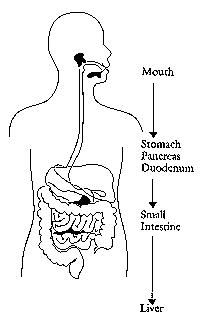Proteins are first broken down in the stomach by hydrochloric acid, pepsin, and proteases into peptides (amino acid chains) by splitting peptide bonds between the amino acid protein chains. In the first part of the small intestine, the duodenum, the pancreatic enzyme trypsin continues the conversion of the polypeptides into dipeptides (two amino acids) and tripeptides (three amino acids). Farther along the small intestine, amino peptidases, including dipeptidases, reduce the proteins to single amino acids. These individual amino acid molecules are then absorbed into the bloodstream through the intestinal wall and carried to the liver through the portal vein circulation.
The liver is the main site and regulator of amino acid metabolism, which may also take place throughout the body. Proteins are made and broken down daily. About 60–70 percent of amino acids available in the body are recycled from old tissue proteins. These recycled amino acids are called endogenous amino acids; new ones from the diet are termed exogenous. Each cell has the capability of building its needed proteins from either or both sources of amino acids.
Protein synthesis is a fairly complex though well-documented process that is described in detail in most biochemistry texts. DNA (deoxyribonucleic acid) controls and guides protein formation with the assistance of RNA (ribonucleic acid) through a duplication and replication process. Each protein has a specific sequence of amino acids used in the genetic code in our DNA.
Most of the amino acids, probably three-fourths, are used to form body proteins such as enzymes, hormones, antibodies, and the tissue proteins such as muscle. Some amino acids are metabolized into other tissue substances, such as melanin (pigmentation hormone), epinephrine, creatine, niacin, choline, and so on. Most often, protein is synthesized at the site in which it is to be used. Every day, protein is made (this process is called anabolism) and broken down (this is called catabolism). This daily process determines the nitrogen (found only in proteins, not fats or carbohydrates) balance of the body. With an increase in protein intake, the body will have a positive nitrogen balance and growth can occur. If we have deficient protein intake, the body will have a negative nitrogen balance. Most of our lives we want to have a neutral nitrogen balance. The average healthy adult synthesizes about 250–350 grams (this number may also be much higher) of protein daily. Depending on protein and amino acid intake, our activity, and protein utilization, we can move into positive or negative nitrogen balance and either build more protein or lose some, which influences body weight, shape, and tone. Excess protein can be turned into fat and stored in the body as potential fuel or as glycogen in the liver. A wide variety of functional problems.
Metabolism of Proteins from Ingestion to the Liver
 Protein Intake
Protein Intake
(long amino acid chains)
Hydrochloric Acid, Pepsin and Proteases (enzymes) split peptide bonds between amino acid chains — turning them into long chain polypeptides.
Pancreatic enzyme Trypsin turns long chain polypeptides into shorter chain polypeptides, tripeptides (3 amino acids) and dipeptides (2 amino acids).
Amino Peptidases and Dipeptidases turn polypeptides, tripeptides and dipeptides into single amino acids, which are actively transported through the wall of the intestines into the bloodstream and then via the portal vein to the LIVER, the principal site of PROTEIN metabolism.